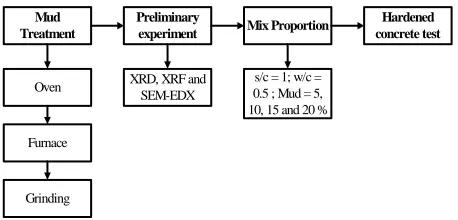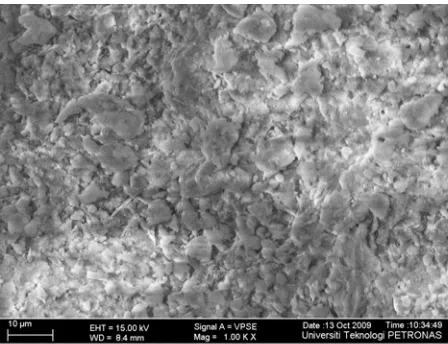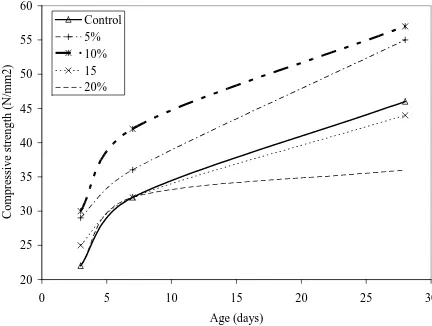Sidoarjo Mud: A Potential Cement Replacement Material
Nuruddin, M.F.1), Bayuaji, R.1,2), Masilamani, M.B.1, Biyanto, T.R.1,2)
Abstract: This paper presents an experimental and analytical research conducted to study the properties of mortar when treated Sidoarjo mud was added into the mix replacing partially the cement content. The replacements were done at 0, 5, 10, 15, and 20%. Compression, tensile, porosity and Ultrasonic Pulse Velocity (UPV) tests were conducted to evaluate the effect of Sidoarjo mud in mortar. Analyses on the mud were also conducted through X-ray diffraction (XRD), ray Fluorescence (XRF), and scanning electron microscope with an energy dispersive X-ray analysis system (SEM-EDX). The results showed that the mud could be used as a cementitious material with optimum ordinary Portland cement (OPC) replacement at 10%.
Keywords: Sidoarjo mud, mortar, cement replacement material
Introduction
Sidoarjo mud has become a major issue when it surfaced from the bowels of the earth and impacted not only to the environment but also to the people at the vicinity. Observations collected indicated that the
27th May 2006 earthquake might have triggered [1]
the eruption in Porong, Sidoarjo. Since 29th May
2006 the mud flows out continuously and spreads over the surrounding area. It has now covered more than 400 Ha of productive land and has completely immersed many villages.
The efforts to explore the preliminary finding [2] of the Sidoarjo mud and its potential use in geopolymer concrete have been conducted [3].
By and large improvement of concrete durability [4] and strength are the criteria in focus by many researchers. A large amount of research has been carried out to study both the durability and strength of concrete to obtain high performance concrete.
One of the basic aspects of the production of high strength concrete is the use of supplementary cementing material. Due to growing environmental concerns, the need to conserve energy and resources considerable efforts have been made worldwide to utilize local natural waste.
A study that examines the possibility of utilizing [5] the mud with the purpose of reducing the use of cement and mitigating the social impact of the mud in the environment [6-8] is a commendable effort.
1) Universiti Teknologi PETRONAS, Perak, Malaysia
Email: [email protected]
2) Institut Teknologi Sepuluh Nopember, Surabaya, Indonesia
Note: Discussion is expected before June, 1st 2010, and will be published in the “Civil Engineering Dimension” volume 12, number 2, September 2010.
Received 10 July 2009; revised 13 December 2009; accepted 16 December 2009.
The mud has degree matrix elements similar to pozzolan chemical compositions. Its natural
characteristic, that contains SiO2 element, can be
categorized as a cement replacement material. This is due to their capacity to react with calcium hydroxide (CH) [9] produced during the hydration of Portland cement. It is well known that the compounds formed during this pozzolanic reaction enhance concrete micro structure.
To produce an extremely good concrete the properties such as strength, compressibility, impermeability and resistibility must be taken into consideration. The aim of the study is to establish whether Sidoarjo mud known as hot mud from Jawa Timur, Indonesia, can be used as a supplementary cementitious material for concrete.
Experimental Detail
Figure 1 depicts the experiment conducted in this research that includes mud treatment, preliminary experiment, mix proportion and hardened concrete test.
Oven
Furnace
XRD, XRF and SEM-EDX
Grinding
Mix Proportion Mud
Treatment
Preliminary experiment
Hardened concrete test
s/c = 1; w/c = 0.5 ; Mud = 5, 10, 15 and 20 %
Figure 1. Experimental details
In this work, the solid mud was obtained from Porong, Sidoarjo, Indonesia. Fresh mud was heated
up at 105 oC for 24 hours to remove the water
produce large amount of smoke. In order to acquire improved quality pozzolanic powder, the mud was
burnt until 600oC for one hour duration using
electrical furnace. The heat profile of the burning procedure is shown in Figure 2.
0 100 200 300 400 500 600 700
0 20 40 60 80 100 120 140 160 180 200
Duration time (minutes)
T
em
p
er
at
u
re (
d
eg
ree
cel
ci
u
s)
Figure 2: The heat profile for mud burning
Figure 3. The burned mud produced after grinding
Five kg of the mud was then ground (3000 cycles) in a ball mill to increase its fineness. The mud has particle size similar to cement and it could function also as microstructure filler at the interfacial transition zone (ITZ). The ordinary Portland cement (OPC) particle was in the range of 100 micron in size and the mud was sieved to obtain particle which was smaller than 100 micron. The burned mud that was processed by burning and grinding is presented in Figure 3. The presence of silica in the mud was then verified with scanning electron microscope with an energy dispersive X-ray analysis system (SEM-EDX)
and X-ray Fluorescence (XRF) equipment.
Energy dispersive X-ray (EDX) is an analytical technique used for the elemental analysis or chemical characterization of a sample. X-ray fluorescence (XRF) is a spectroscopic method that is commonly used for solids in which secondary X-ray emission is generated by excitation of a sample with X-rays. X-Ray Diffraction (XRD) can be used to analyze the crystalline properties of a material. Graph patterns of XRD analysis can show whether the material is in amorphous, partially crystalline, or crystalline state.
To understand the effect of Sidoarjo mud on hardened concrete, various test where conducted in the laboratory. The detail such as sample size, number of sample, age of test and standards are shown in Table 1
Table 2 shows the chemical composition of OPC used in the experiment. Five different mixes with percentage replacement of OPC by Sidoarjo mud at 0, 5, 10, 15, and 20% OPC replacement were adopted. Water cement (w/c) ratio was taken as 0.5 and sand cement (s/c) ratio was capped as 1.
Table 1. The macro structure experimental details
Sample Description
Test Size (mm) No Age (days) Standard Unit Measure Equipment
Strength 50 x 50 x 50 3 3,7,28 BS1881:Part
116:1983 N/mm² Compression
Compression testing machine (3000KN)
Tensile 100 x 200 3 28 BS1881:Part
117:1983 N/mm² Split/ Tensile
Compression testing machine (3000KN)
Porosity 1" x 2" 3 28 BS1881:Part
124:1988 % Ratio of void or air spaces
Vacuum bowl and weighing machine
UPV 50 x 50 x 50 3 3,7,28 BS1881:Part
Table 2. Chemical properties of OPC
Oxide composition OPC, weight (%)
Na2O 0.02 MgO 1.43 Al2O3 2.84 SiO2 20.40 P2O5 0.10 K2O 0.26 CaO 67.70 TiO2 0.17 Fe2O3 4.64 SO3 2.20 SO2 0.16
Results and Discussions
Microstructure Analyses
Table 3 and Table 4 show the chemical properties of Sidoarjo mud before and after burning that were identified using SEM-EDX and XRF equipment respectively. Whilst Figure 3a and 3b show the SEM micrograph of mud before and after burning. Both mud samples have similar smooth, dense and compacted surface. Figure 4 describes the properties of mud in term of its amorphousness.
Table 3. The results achieved by SEM-EDX
Element Before burning, (%-mol) after burning, (%-mol)
C 15.2 12.7 O 45.1 51.7 Na 0.9 0.9
Mg 1.0 1.1
Al 9.4 8.1 Si 19.6 21.4 Cl 0.7 0.6 K 1.5 0.3 Ca 1.1 1.0
Ti 0.7 1.7 Fe 4.8 0.4
Total 100.0 100.0
Table 4. The results achieved by XRF
Oxides before burning,
(%)
after burning, (%)
CaO 4.897 4.692
SiO2 54.9 56.08
Al2O3 20.44 20.64
Fe2O3 10.64 9.616
K2O 2.352 2.271
MgO 1.76 1.8
SO3 1.31 2.01
MnO 0.213 0.202
ZnO 0.0174 0.0149
Rb2O 0.01 0.0095
Cl 1.14 0.611
P2O5 1.06 0.927
Br 0.008 0
TiO2 1.16 1.06
ZrO2 0.0231 0
CuO 0 0.0028
SrO 0.07 0.0653
Total 100 100
Figure 3a. SEM micrograph of mud before burning
Figure 3b.. SEM micrograph of mud after burning.
Figure 4. XRD result of mud after burning
Compressive Strength
20
Figure 5: Compressive strength development against time
It can be seen that the concrete strength is affected by the percentage of mud inclusions. It is evident that 10% of mud reacted well with the mixture of mortar and depict higher compressive strength compared to all other types of mortar at all ages. The 5% mixture also showed higher compressive strength compared to OPC samples but on the contrary lower compressive strengths were obtained for 15% and 20% replacement levels. At 28 days percentage differences, with respect to OPC samples of about 30%, 20%, -5%, -30% were obtained for 10%, 5%, 15% and 20% replacement respectively. Judging from the results obtained for 5% and 10% replacements it can be concluded that the mud can be used as a cement replacement material.
Tensile Strength
Figure 6 shows the effect of mud on tensile strength of concrete. It is evident that Sidoarjo mud concrete regardless of percentage replacement showed better tensile strengths compared to normal OPC mortar. It was also found that 10% replacement gave the highest tensile value i.e. 9.3% higher than control sample. The samples with 5%, 15% and 20% mud replacements showed 5.8%, 5.8%, 4.0% increase compared to normal concrete respectively. It is believed that chemical contents such as calcium, silica, and alumina were instrumental in enhancing the cement reaction hydration process.
Porosity
The technique of vacuum saturation is conducted to measure the porosity of the mortar. Experts have widely agreed for decades that the use of pozzolana or supplementary cementing materials (SCM) can reduce porosity. Figure 7 shows that the mud reduces the void ratio in the mixture. During hydration process, calcium hydroxide reacted with the pozzolana and increased the interlocking capability in the mixture. It is evident that this mud can reduce the void in the mixture and 10 % replacement seems to be giving the least porosity. A reduction of porosity of about 6% can be seen from
the 10% inclusion whereas the other percentage inclusions did not have significant difference compared to OPC samples.
4.1
Percentage of mud (%)
Splitti
Figure 6. Tensile strength at 28 days
29.5
Percentage of mud (%)
P
Figure 7. Porosity level
Integrity
Figure 8 shows the UPV test results for the various percentages of mud replacements. Again it was found that 10% replacement showed the best result even though the difference is very small (about 1.8%) as compared to control OPC sample. After 10% replacement, UPV values decreased with increasing mud replacement as it occurred for compressive strength.
Percentage of Mud (%)
V
elocity (m
/s
)
Conclusion
In conclusion, it can be confirmed that treated Sidoarjo mud from Porong, Sidoarjo, Jawa Timur, Indonesia can be utilized as a cement replacement material with 10% replacement as the optimum value. Sidoarjo mud can improve the compressive strengths, integrity and able to reduce the porosity of mortar. Nevertheless, its influences on tensile, porosity and integrity are small as compared to compressive strength. Utilization of this material, as cement replacement material, that is available in abundance in Sidoarjo can not only mitigate social and environmental problems but also improve concrete properties.
Acknowledgement
The authors wish to express their sincere appreciation to Universiti Teknologi PETRONAS for providing the facilities and financial grant in conducting the research.
References
1. Mazzini, H.S., Akhmanov, G.G., Aloisi, G., Planke, S., and Malthe-Sørenssen, I.A., Triggering and Dynamic Evolution of the LUSI
Mud Volcano, Indonesia, Earth and Planetary
Science Letters261, 2007, pp. 375–388.
2. Geoffrey, S.P., Thomas, J.C., Handoko, T.W., Robert, J.R., Craig, A.J., George, N.B., Heather, A. L., Ruth, E. W., Philip, L. H., Harland, G.,
Michael, W.A., Cyrus, J.B., David, L.F., Gregory,
P.M., and Suzette, A.M., Preliminary Analytical
Results for a Mud Sample Collected from the LUSI Mud Volcano, Sidoarjo, East Java, Indonesia, U.S. Geological Survey, 2008.
3. Triwulan, T., Januarty, J.E., and Tami, A., Analisa Sifat Mekanik Beton Geopolimer Berbahan Dasar Fly Ash dan Lumpur Porong Kering Sebagai
Pengisi, Jurnal TORSI, Nopember 2007, Tahun ke
27, no 3, 2007, pp. 33-45.
4. Neville, A.M., Properties of Concrete, 4th edn., Longman, London, 2006.
5. Agarwal, S., Pozzolanic Activity of Various
Siliceous Materials, Cement and Concrete
Research, Vol. 36, 2006, pp. 1735– 1739.
6. Na Zhanga, H.S., Xiaoming, L., Jixiu, Z., Early-age Characteristics of Red Mud–Coal Gangue
Cementitious Material, Journal of Hazardous
Materials, Vol. 167, 2009, pp. 927-932.
7. Papadakis, V.G., Tsimas, S., Greek Supple-mentary Cementing Materials and Their
Incorporation in Concrete, Cement & Concrete
Composites, Vol. 27, 2005, pp. 223–230.
8. Ayangade, J.A., Alake, O., and Wahab, A. B., The Effects of Different Curing Methods on the
Compressive Strength of Terracrete, Civil
Engineering Dimension, Vol. 11, No. 1, 2009, pp. 41-45.
9. Mehta, P.K., Siliceous Ashes and Hydraulic



